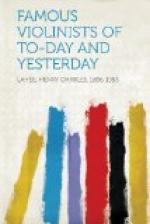The pupils of Corelli were Somis, Locatelli, Geminiani (Italians), and Anet (a Frenchman), whose pupil Senaille was also French. The greatest pupil of Somis was Pugnani, an Italian, and his greatest pupil was Viotti, a Piedmontese, who founded the French school, and from him came Roberrechts, his pupil De Beriot and his pupil Vieuxtemps, the two latter Belgians, also Baillot, etc., down to Marsick and Sarasate, a Spaniard, while through Rode, a Frenchman, we have Boehm (school of Vienna) and his pupil Joachim, a Hungarian (school of Berlin).
Several violinists are found under two schools, as for instance, Pugnani, who was first a pupil of Tartini and later of Somis, and Teresa Milanollo, pupil of Lafont and of De Beriot, who appear under different schools.
The only conclusion to be drawn is that the greatest violinists were really independent of any school, and, by their own genius, broke loose from tradition and established schools of their own. Some of them, on the other hand, had but few pupils, as for instance, Paganini, who had but two, and Sarasate. Many also were teachers rather than performers. We have to deal chiefly with the virtuosi.
CHAPTER II.
1650 To 1750.
Arcangelo Corelli, whose name is recognised as one of the greatest in the history of violin playing and composition, and who laid the foundation for all future development of technique, was born in 1653, at Fusignano, near Imola, in the territory of Bologna.
He showed an early propensity for the violin, and studied under Bassani, a man of extensive knowledge and capabilities, while Mattei Simonelli was his instructor in counterpoint.
Corelli at one time sought fame away from home, and he is said to have visited Paris, where Lulli, the chief violinist of that city, exhibited such jealousy and violence that the mild-tempered Corelli withdrew. In 1680 he went to Germany, where he was well received, and entered the service of the Elector of Bavaria, but he soon returned to Rome. His proficiency had now become so great that his fame extended throughout Europe, and pupils flocked to him. His playing was characterised by refined taste and elegance, and by a firm and even tone.
[Illustration: ARCHANGE Corelli]
When the opera was well established in Rome, about 1690, Corelli led the band. His chief patron in Rome was Cardinal Ottoboni, and it was at his house that an incident occurred which places Corelli at the head of those musicians who have from time to time boldly maintained the rights of music against conversation. He was playing a solo when he noticed the cardinal engaged in conversation with another person. He immediately laid down his violin, and, on being asked the reason, answered that “he feared the music might interrupt the conversation.”
Corelli was a man of gentle disposition and simple habits. His plainness of dress and freedom from ostentation gave the impression that he was parsimonious, and Handel says of him that “he liked nothing better than seeing pictures without paying for it, and saving money,” He was also noted for his objection to riding in carriages.




